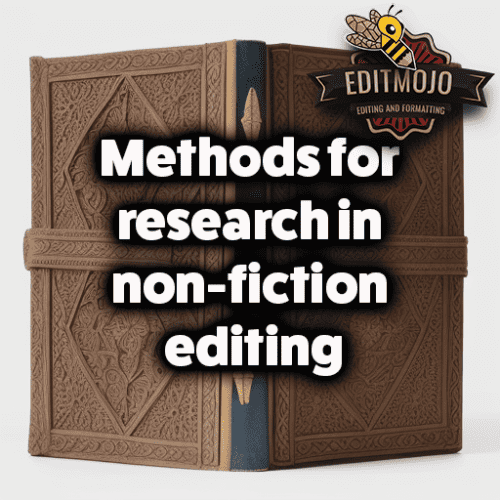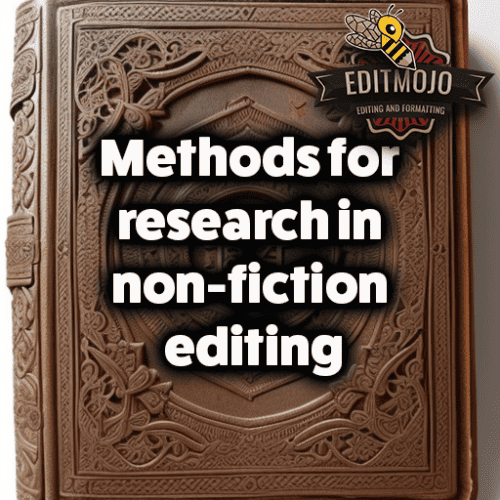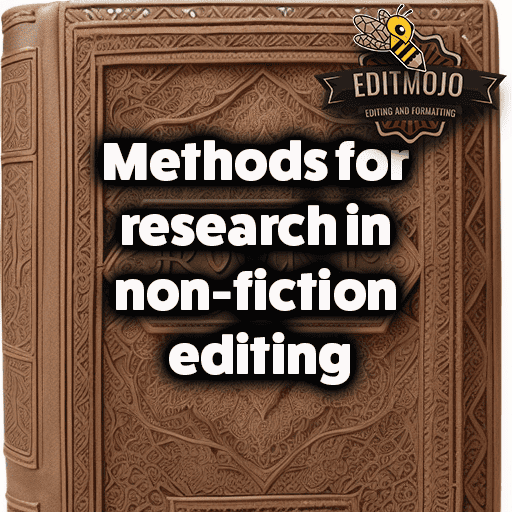Methods for research in non-fiction editing
Methods for research in non-fiction editing. Editing is the hidden craft behind great works, and non-fiction editing is a particularly intricate art. It is about upholding facts, preserving authenticity, and adding clarity to an author’s voice, all while maintaining the distinctiveness of the narrative. Research is an invaluable tool in this process. This post will delve into why research is critical in non-fiction editing and how you can use different research methods to enhance your editing skills.
Key Takeaways Table
| Key Points | Summary |
|---|---|
| Understanding Non-Fiction Editing | Non-fiction editing involves various types including developmental, substantive, copy-editing, and proofreading. Each type serves a unique purpose and the editor is responsible for both language accuracy and factual authenticity. |
| Importance of Research in Non-Fiction Editing | Research is critical in non-fiction editing for fact-checking, building trust with the reader, and ensuring legal and ethical compliance. |
| Common Research Methods | Various research methods are employed in non-fiction editing including literature review, interviews, archival research, surveys and questionnaires, and internet research. |
| Efficient Use of Research Methods | Each research method requires a distinct approach. For instance, preparation for interviews, a systematic approach for literature review, patience for archival research, and critical analysis for internet research are all vital. |
| Advanced Research Techniques | AI and machine learning, meta-analysis, and big data analysis are advanced techniques that can significantly enhance research in non-fiction editing. |
| Case Study: The Impact of Rigorous Research | The book The Immortal Life of Henrietta Lacks is a perfect example of the importance of rigorous research in non-fiction editing, emphasizing the need for interviews, archival research, and extensive literature review. |
| Future of Research in Non-Fiction Editing | Emerging trends suggest a rise in interdisciplinary research and further influence of AI and technology on research in non-fiction editing. |
Understanding Non-Fiction Editing
Non-fiction editing, like a prism, reflects different facets. It encompasses developmental editing, substantive editing, copy-editing, and proofreading. Each stage serves a unique purpose, from shaping the structure and content to refining the language and checking for typographical errors. The responsibility of a non-fiction editor is multi-fold. Beyond language and grammar, they are accountable for the accuracy of the content. It’s like being a detective, constantly in pursuit of truth and clarity.
Non-fiction editing presents a unique set of challenges. The most significant is ensuring that every claim, every fact, every date is accurate. For this very reason, research becomes the beacon guiding the non-fiction editor’s journey.

The Importance of Research in Non-Fiction Editing
In non-fiction editing, research is the cornerstone. Fact-checking is non-negotiable and is integral to the editing process. A well-researched piece of non-fiction writing not only informs the reader but builds trust. It sets the tone for a meaningful conversation between the author and the reader, fostering a relationship based on trust and respect.
Furthermore, research safeguards the content from legal and ethical complications such as infringement of privacy, defamation, or plagiarism. The moral and legal implications of publishing inaccurate information can be significant, making the role of an editor and their research acumen crucial.
Common Research Methods in Non-Fiction Editing
Research methods used by non-fiction editors are vast and varied. Literature review forms the backbone of research, where editors delve into previously published material to verify facts or gain additional insights. Interviews with subject matter experts provide first-hand information, offering an added layer of authenticity to the content.
Archival research is another essential method, especially when editing historical non-fiction. Exploring historical documents, institutional records, or personal correspondence can offer a wealth of information. Surveys and questionnaires, though less common, can be useful when the content pertains to the general public’s opinion or behavior. And of course, we cannot forget the role of internet research, the omnipresent tool in our digital age, offering instant access to a plethora of information.

How to Efficiently Use These Research Methods
Each research method demands a unique approach. A literature review, for instance, requires a systematic approach. It’s about knowing where to look (libraries, academic databases, government publications, etc.) and how to critically analyze the materials. When interviewing experts, preparation is key. Having a clear set of questions and being an active listener can extract the most beneficial insights.
Archival research requires patience and a keen eye. Sifting through vast amounts of data to find the relevant nuggets of information is no easy task, but the rewards can be immense. When using surveys or questionnaires, the challenge lies in interpreting the data correctly and understanding its implications on the content.
Internet research, while convenient, comes with its own set of challenges – the most significant being the risk of misinformation. Therefore, it’s essential to use reliable sources and cross-verify information. The Stanford Guidelines for Web Credibility is an excellent resource for this.
Advanced Research Techniques in Non-Fiction Editing
The emergence of AI and machine learning has revolutionized many industries, and non-fiction editing is no exception. AI tools can help in fact-checking, sourcing relevant literature, and even identifying patterns in data. Similarly, meta-analysis, the statistical analysis of a large collection of results from individual studies, can provide more precise estimates of effects and help identify patterns or discrepancies.
Data mining and big data are other tools that can significantly impact research in non-fiction editing. These techniques can gather and analyze vast amounts of information, helping editors verify facts, spot trends, and gain deep insights.
Case Study: The Impact of Rigorous Research in Non-fiction Editing
Consider the editing process behind The Immortal Life of Henrietta Lacks by Rebecca Skloot. This book presented a detailed account of Henrietta Lacks and the immortal cell line, known as HeLa, that came from Lacks’s cervical cancer cells in 1951. To maintain the credibility of this sensitive and intricate narrative, Skloot and her editor utilized interviews, archival research, and extensive literature review. The rigorous research behind the scenes ensured that the book was factual, authentic, and engaging.
The Future of Research in Non-fiction Editing
Emerging trends suggest a rise in interdisciplinary research, involving a blend of different research methods to achieve comprehensive results. AI and technology will further refine research in non-fiction editing, enabling editors to work more efficiently and accurately. As non-fiction editors, we must stay adaptive and welcome these changes.

Conclusion (Methods for research in non-fiction editing)
The synergy between non-fiction editing and research is undeniable. It’s a partnership that upholds the integrity of non-fiction writing and reinforces the reader’s trust in written works. As non-fiction editors, we must continually refine our research skills, embrace new methodologies, and remain relentless in our pursuit of accuracy and authenticity.
Resources for Further Learning
For those who wish to delve deeper, I recommend the following resources:
- The Art of Editing in the Age of AI – An insightful read on how AI is influencing the editing world.
- Fact-Checking for Editors – A comprehensive online course offered by Poynter.
- American Society of Journalists and Authors (ASJA) – A great platform for networking and learning from industry professionals.
Remember, in the dynamic world of non-fiction editing, learning and growing are the only constants.
Top Five Questions and Answers Table
| Questions | Answers |
|---|---|
| What is non-fiction editing? | Non-fiction editing involves refining a non-fiction manuscript by improving language, ensuring factual accuracy, checking for consistency and enhancing the overall readability. |
| Why is research important in non-fiction editing? | Research is vital for fact-checking, reinforcing credibility, and ensuring legal and ethical compliance in non-fiction editing. |
| What are the common research methods in non-fiction editing? | Common research methods include literature review, interviews, archival research, surveys and questionnaires, and internet research. |
| How can AI and machine learning help in non-fiction editing research? | AI and machine learning can aid in fact-checking, sourcing relevant literature, identifying patterns in data, and making the overall research process more efficient. |
| What does the future hold for research in non-fiction editing? | The future of research in non-fiction editing will likely see a rise in interdisciplinary research, a further influence of AI and technology, and an emphasis on continuous learning and adaptation. |
